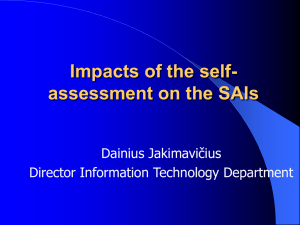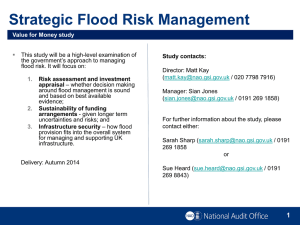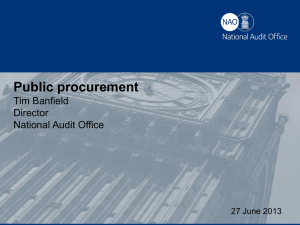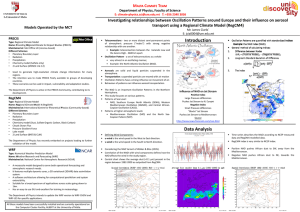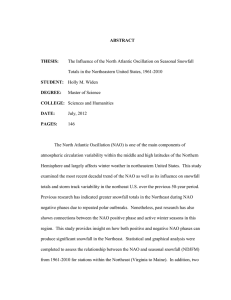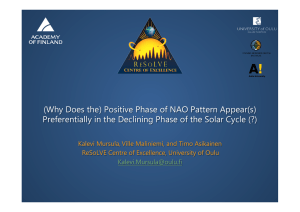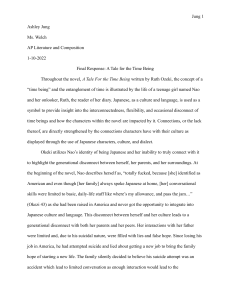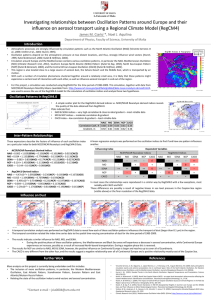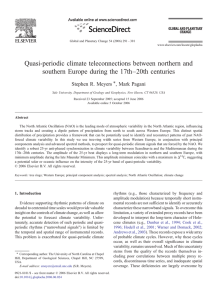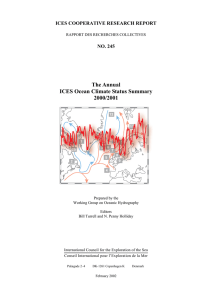Positive NAO Index
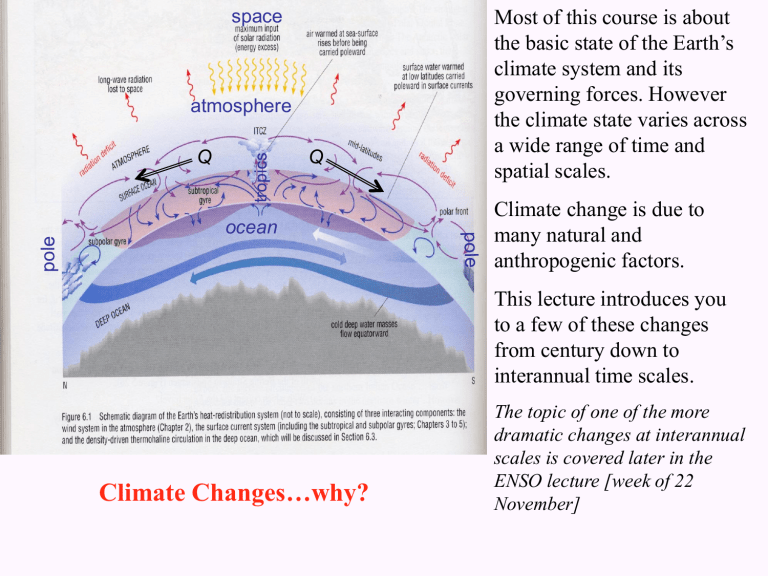
space atmosphere
Q Q ocean
Climate Changes…why?
Most of this course is about the basic state of the Earth’s climate system and its governing forces. However the climate state varies across a wide range of time and spatial scales.
Climate change is due to many natural and anthropogenic factors.
This lecture introduces you to a few of these changes from century down to interannual time scales.
The topic of one of the more dramatic changes at interannual scales is covered later in the
ENSO lecture [week of 22
November]
Last 1000 years
Warm period
Proxy data:anecdotal tree ring, coral, ice core
Instrumental data
Cold period
Little Ice Age
?
Now [what have we done!] hotter sun more sunspots colder sun less sunspots
Solar and greenhouse/aerosols
Greenhouse gasses & aerosols solar
Solar radiation, Q s w/m 2
Solar Constant S = 1375
S p a c e
Q s
(1a )/4 = es T e
4
Solar radiation, Q s
T e
= 18°C
Q b
= es T e
4
Q b
= es T e
4
300 m
T e
In a greenhouse enhanced world, the
T e is forced to higher elevation
T x e x
Lapse rate, 7°C/km x x x x x x x x x
Lapse rate, 7°C/km x x x x x x x x x x x x x
D T=2.1°C x x
Natural greenhouse
Earth Surface
enhanced x Greenhouse molecule, H
2
0, CO
2 x x greenhouse
North Atlantic Oscillation, NAO http://www.ldeo.columbia.edu/NAO http://sciencebulletins.amnh.org/earth/f/nao.20040910/
The NAO is the dominant mode of winter climate variability in the North Atlantic region ranging from central North America to Europe and much into
Northern Asia. The NAO is a large scale seesaw in atmospheric mass between the subtropical high and the polar low. The corresponding index varies from year to year, but also exhibits a tendency to remain in one phase for intervals lasting several years.
Positive NAO Index
• The Positive NAO index phase shows a stronger than usual subtropical high pressure center and a deeper than normal Icelandic low.
• The increased pressure difference results in more and stronger winter storms crossing the
Atlantic Ocean on a more northerly track.
• This results in warm and wet winters in Europe and in cold and dry winters in northern Canada and Greenland
• The eastern US experiences mild and wet winter conditions
Negative NAO Index
The negative NAO index phase shows a weak subtropical high and a weak Icelandic low.
The reduced pressure gradient results in fewer and weaker winter storms crossing on a more west-east pathway.
They bring moist air into the Mediterranean and cold air to northern Europe
The US east coast experiences more cold air outbreaks and hence snowy weather conditions.
Greenland, however, will have milder winter temperatures
part of NADW phenomena
Part of subtropical wind driven circulation
Cape Hatteras, 80 Sv
Florida Straits, 30 Sv
Decadal ENSO, tied to North Pacific?
Mostly neutral
Mostly El Niño
NAO relationship to PDO?
Northern Annular Mode [NAM] or
Arctic Oscillation
A Positive NAM Event: the winter pressure at the pole is relatively low, cold air does not move as quickly pole ward, allowing the stratospheric winds to “spin up” vortex.
Once a strong vortex is established it acts as a barrier, keeping cold air in the arctic, and allowing for warmer winters in Scandinavia and North America
A Negative NAM Event : the pressure at the pole is high, cold air spills southward creating a very irregular jet stream shape, making the US and Scandinavia very cold, and promoting mid-latitude storms
In this case the polar vortex is weak
Recent History of the NAM
There has been a general trend favoring a positive NAM state in recent years.
NAO/NAM/PDO connection?
THE ANTARCTIC OSCILLATION (or Southern Annular Mode)
is the primary mode of atmospheric variability poleward of 30°S, and may also account for much of the variability in ocean circulation and sea ice in this region.
Thompson and Wallace (2000)
A schematic of the hypothesized relationships among atmospheric, ocean, and ice components of the Southern
Hemisphere climate system associated with the positive phase of the AAO. These relationships were seen in a coupled ocean-atmosphere simulation (Hall and
Visbeck, 2002).
Climate Change happens! over a wide range of temporal and spatial scales; for lots of reasons, both natural and societal; the network of positive and negative feedbacks between the various elements of the climate system and imperfect observation system makes detection, understanding and modeling a real challenge.
